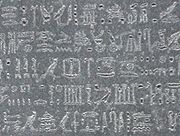
Quadrat (hieroglyph block)
Encyclopedia
A quadrat block is a virtual rectangle
or square
in Egyptian hieroglyphic
text.
The glyphs (hieroglyphs) can be variable in number within the virtual block, though they are often proportioned according to variable standardized rules of scribal
methods.
The definition for the block in Illustrated Hieroglyphics Handbook by Schumann-Antelme and Rossini, is: "A 'quadrate' is a virtual square, which although not drawn, guides the hand of the scribe. Hieroglyphs must be aesthetically positioned within the quadrate and their size must be proportioned accordingly. They form groups that are pleasing to the eye and based on the laws of balance."
 An example of 5 lines of text from the Rosetta Stone
An example of 5 lines of text from the Rosetta Stone
, (lines 9, 10, 11, 12, 13), shows a width of about six to seven virtual blocks. Line 12, (fourth line) is illustrative of the variable size, in this case the widths, of the 'virtual quadrate blocks'.
(See: N-red crown (n hieroglyph)
, N-water ripple (n hieroglyph)
)
Rectangle
In Euclidean plane geometry, a rectangle is any quadrilateral with four right angles. The term "oblong" is occasionally used to refer to a non-square rectangle...
or square
Square (geometry)
In geometry, a square is a regular quadrilateral. This means that it has four equal sides and four equal angles...
in Egyptian hieroglyphic
Egyptian hieroglyphs
Egyptian hieroglyphs were a formal writing system used by the ancient Egyptians that combined logographic and alphabetic elements. Egyptians used cursive hieroglyphs for religious literature on papyrus and wood...
text.
The glyphs (hieroglyphs) can be variable in number within the virtual block, though they are often proportioned according to variable standardized rules of scribal
Scribe
A scribe is a person who writes books or documents by hand as a profession and helps the city keep track of its records. The profession, previously found in all literate cultures in some form, lost most of its importance and status with the advent of printing...
methods.
The definition for the block in Illustrated Hieroglyphics Handbook by Schumann-Antelme and Rossini, is: "A 'quadrate' is a virtual square, which although not drawn, guides the hand of the scribe. Hieroglyphs must be aesthetically positioned within the quadrate and their size must be proportioned accordingly. They form groups that are pleasing to the eye and based on the laws of balance."
Rosetta Stone closeup

Rosetta Stone
The Rosetta Stone is an ancient Egyptian granodiorite stele inscribed with a decree issued at Memphis in 196 BC on behalf of King Ptolemy V. The decree appears in three scripts: the upper text is Ancient Egyptian hieroglyphs, the middle portion Demotic script, and the lowest Ancient Greek...
, (lines 9, 10, 11, 12, 13), shows a width of about six to seven virtual blocks. Line 12, (fourth line) is illustrative of the variable size, in this case the widths, of the 'virtual quadrate blocks'.
- The time of the festivals are stated as: "...day 1 up to day 5...", (three blocks)
- The three blocks:
(See: N-red crown (n hieroglyph)
N-red crown (n hieroglyph)
The ancient Egyptian Red Crown, the Deshret crown, is one of the oldest Egyptian hieroglyphs. As an iconographic element, it is used on the famous Narmer Palette of Pharaoh Narmer as the "Red Crown of the Delta", the Delta being Lower Egypt....
, N-water ripple (n hieroglyph)
N-water ripple (n hieroglyph)
The ancient Egyptian ripple of water is one of the oldest language hieroglyphs from Ancient Egypt. It is used on a famous cartouche of Pharaoh Den of the First dynasty....
)

